Detailed Construction Management Plan: Kingspark Road, West Perth
VerifiedAdded on 2023/06/11
|51
|16370
|246
Project
AI Summary
This construction management plan outlines the approach for a commercial and residential complex project located on Kingspark Road, West Perth. It addresses key aspects such as site establishment, environmental management, traffic management, and occupational health and safety. The plan aims to minimize disruptions to stakeholders, including residents and public transport, while adhering to legal and regulatory requirements. It details the project's phases, resource management, and strategies for mitigating environmental impacts like dust and noise. The document emphasizes compliance with local authorities and obtaining necessary permits for demolition, excavation, and construction, ensuring a coordinated and environmentally conscious construction process. Desklib provides a platform for students to access this and other solved assignments to aid in their studies.
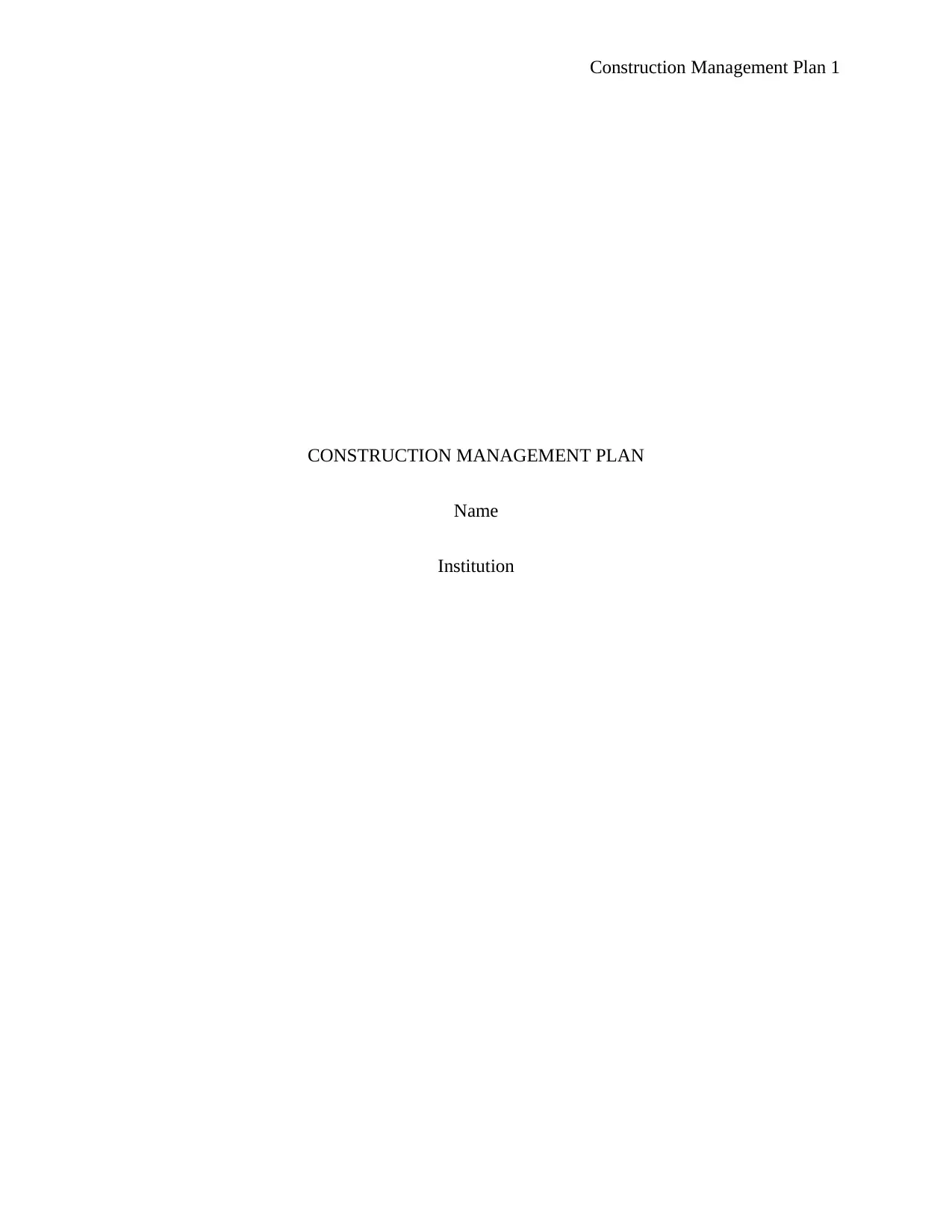
Construction Management Plan 1
CONSTRUCTION MANAGEMENT PLAN
Name
Institution
CONSTRUCTION MANAGEMENT PLAN
Name
Institution
Paraphrase This Document
Need a fresh take? Get an instant paraphrase of this document with our AI Paraphraser
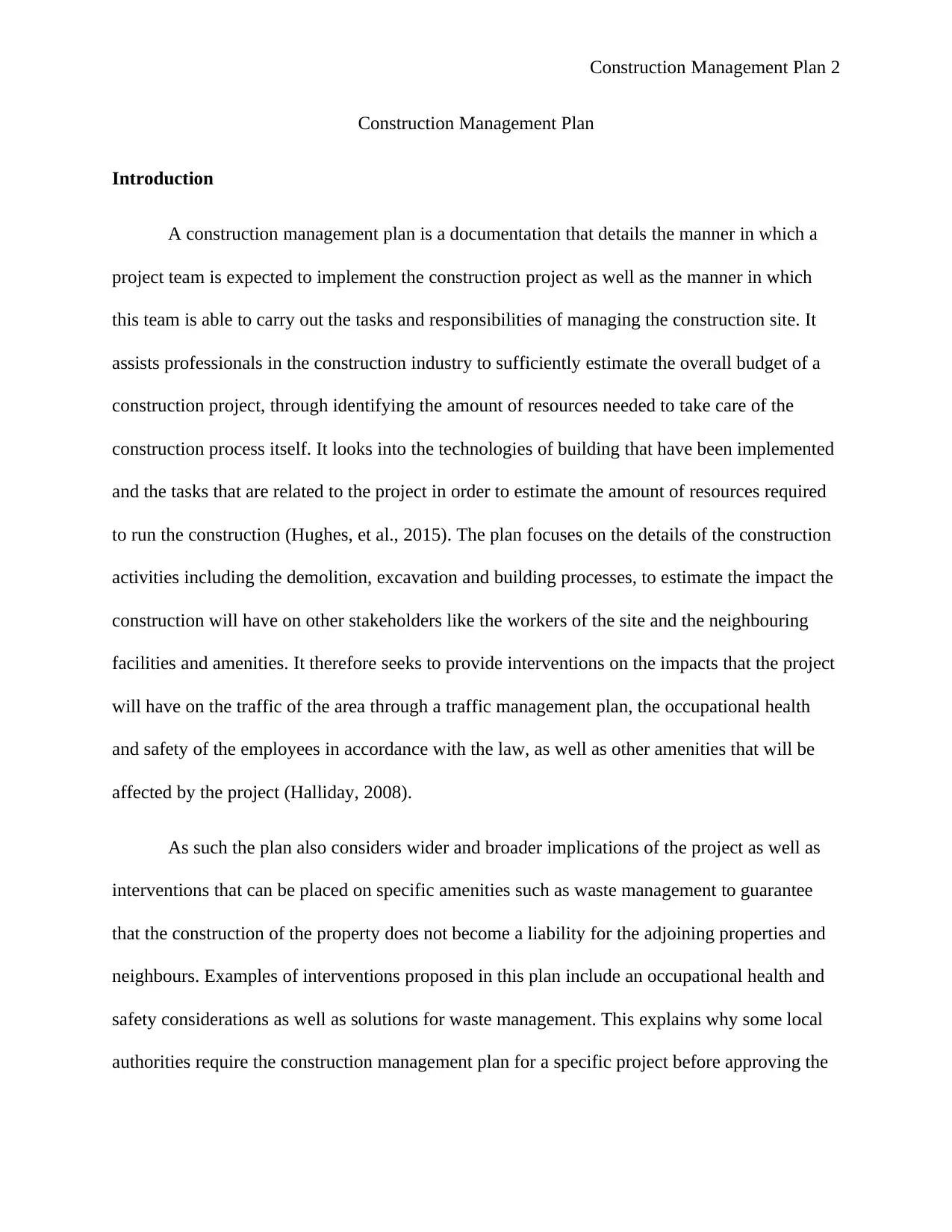
Construction Management Plan 2
Construction Management Plan
Introduction
A construction management plan is a documentation that details the manner in which a
project team is expected to implement the construction project as well as the manner in which
this team is able to carry out the tasks and responsibilities of managing the construction site. It
assists professionals in the construction industry to sufficiently estimate the overall budget of a
construction project, through identifying the amount of resources needed to take care of the
construction process itself. It looks into the technologies of building that have been implemented
and the tasks that are related to the project in order to estimate the amount of resources required
to run the construction (Hughes, et al., 2015). The plan focuses on the details of the construction
activities including the demolition, excavation and building processes, to estimate the impact the
construction will have on other stakeholders like the workers of the site and the neighbouring
facilities and amenities. It therefore seeks to provide interventions on the impacts that the project
will have on the traffic of the area through a traffic management plan, the occupational health
and safety of the employees in accordance with the law, as well as other amenities that will be
affected by the project (Halliday, 2008).
As such the plan also considers wider and broader implications of the project as well as
interventions that can be placed on specific amenities such as waste management to guarantee
that the construction of the property does not become a liability for the adjoining properties and
neighbours. Examples of interventions proposed in this plan include an occupational health and
safety considerations as well as solutions for waste management. This explains why some local
authorities require the construction management plan for a specific project before approving the
Construction Management Plan
Introduction
A construction management plan is a documentation that details the manner in which a
project team is expected to implement the construction project as well as the manner in which
this team is able to carry out the tasks and responsibilities of managing the construction site. It
assists professionals in the construction industry to sufficiently estimate the overall budget of a
construction project, through identifying the amount of resources needed to take care of the
construction process itself. It looks into the technologies of building that have been implemented
and the tasks that are related to the project in order to estimate the amount of resources required
to run the construction (Hughes, et al., 2015). The plan focuses on the details of the construction
activities including the demolition, excavation and building processes, to estimate the impact the
construction will have on other stakeholders like the workers of the site and the neighbouring
facilities and amenities. It therefore seeks to provide interventions on the impacts that the project
will have on the traffic of the area through a traffic management plan, the occupational health
and safety of the employees in accordance with the law, as well as other amenities that will be
affected by the project (Halliday, 2008).
As such the plan also considers wider and broader implications of the project as well as
interventions that can be placed on specific amenities such as waste management to guarantee
that the construction of the property does not become a liability for the adjoining properties and
neighbours. Examples of interventions proposed in this plan include an occupational health and
safety considerations as well as solutions for waste management. This explains why some local
authorities require the construction management plan for a specific project before approving the
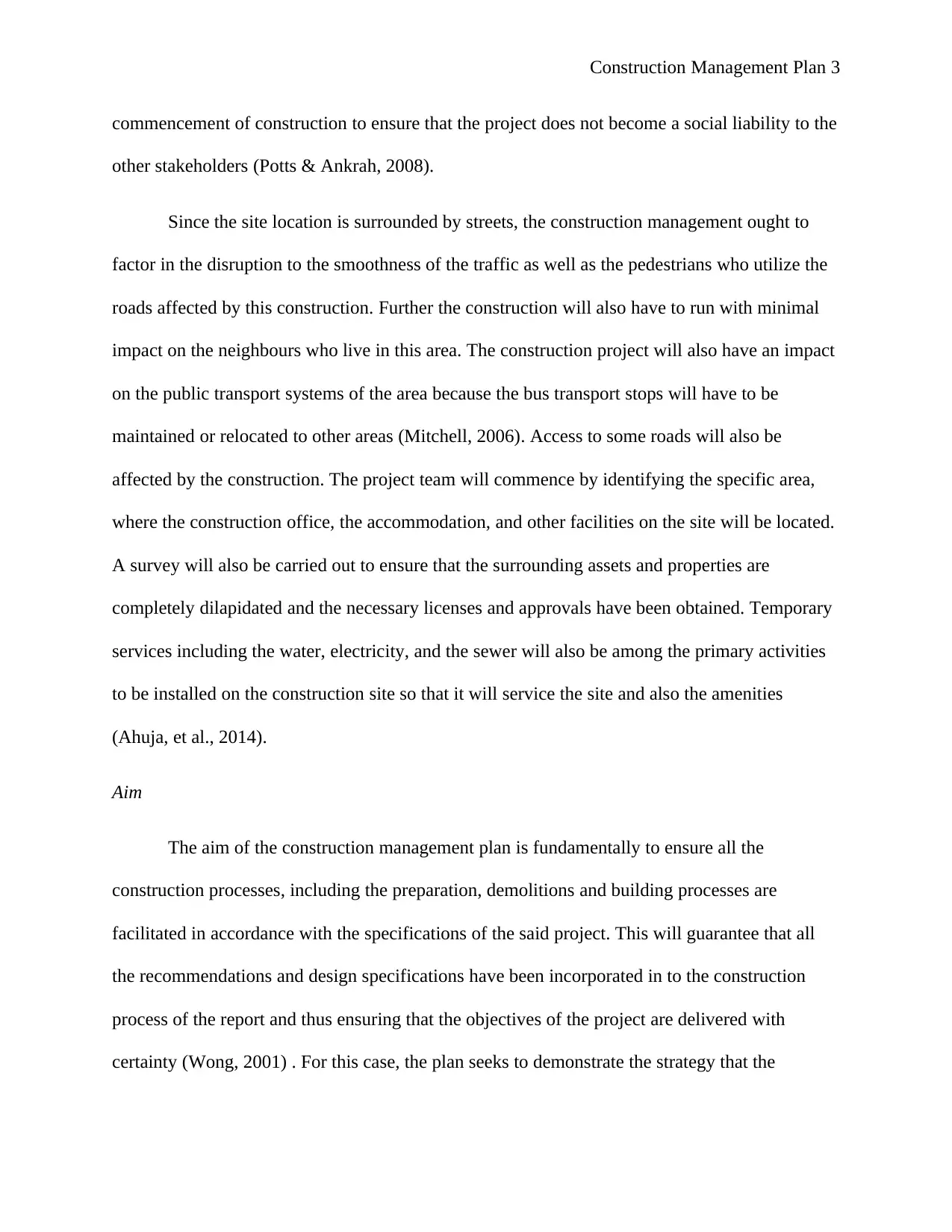
Construction Management Plan 3
commencement of construction to ensure that the project does not become a social liability to the
other stakeholders (Potts & Ankrah, 2008).
Since the site location is surrounded by streets, the construction management ought to
factor in the disruption to the smoothness of the traffic as well as the pedestrians who utilize the
roads affected by this construction. Further the construction will also have to run with minimal
impact on the neighbours who live in this area. The construction project will also have an impact
on the public transport systems of the area because the bus transport stops will have to be
maintained or relocated to other areas (Mitchell, 2006). Access to some roads will also be
affected by the construction. The project team will commence by identifying the specific area,
where the construction office, the accommodation, and other facilities on the site will be located.
A survey will also be carried out to ensure that the surrounding assets and properties are
completely dilapidated and the necessary licenses and approvals have been obtained. Temporary
services including the water, electricity, and the sewer will also be among the primary activities
to be installed on the construction site so that it will service the site and also the amenities
(Ahuja, et al., 2014).
Aim
The aim of the construction management plan is fundamentally to ensure all the
construction processes, including the preparation, demolitions and building processes are
facilitated in accordance with the specifications of the said project. This will guarantee that all
the recommendations and design specifications have been incorporated in to the construction
process of the report and thus ensuring that the objectives of the project are delivered with
certainty (Wong, 2001) . For this case, the plan seeks to demonstrate the strategy that the
commencement of construction to ensure that the project does not become a social liability to the
other stakeholders (Potts & Ankrah, 2008).
Since the site location is surrounded by streets, the construction management ought to
factor in the disruption to the smoothness of the traffic as well as the pedestrians who utilize the
roads affected by this construction. Further the construction will also have to run with minimal
impact on the neighbours who live in this area. The construction project will also have an impact
on the public transport systems of the area because the bus transport stops will have to be
maintained or relocated to other areas (Mitchell, 2006). Access to some roads will also be
affected by the construction. The project team will commence by identifying the specific area,
where the construction office, the accommodation, and other facilities on the site will be located.
A survey will also be carried out to ensure that the surrounding assets and properties are
completely dilapidated and the necessary licenses and approvals have been obtained. Temporary
services including the water, electricity, and the sewer will also be among the primary activities
to be installed on the construction site so that it will service the site and also the amenities
(Ahuja, et al., 2014).
Aim
The aim of the construction management plan is fundamentally to ensure all the
construction processes, including the preparation, demolitions and building processes are
facilitated in accordance with the specifications of the said project. This will guarantee that all
the recommendations and design specifications have been incorporated in to the construction
process of the report and thus ensuring that the objectives of the project are delivered with
certainty (Wong, 2001) . For this case, the plan seeks to demonstrate the strategy that the
⊘ This is a preview!⊘
Do you want full access?
Subscribe today to unlock all pages.

Trusted by 1+ million students worldwide
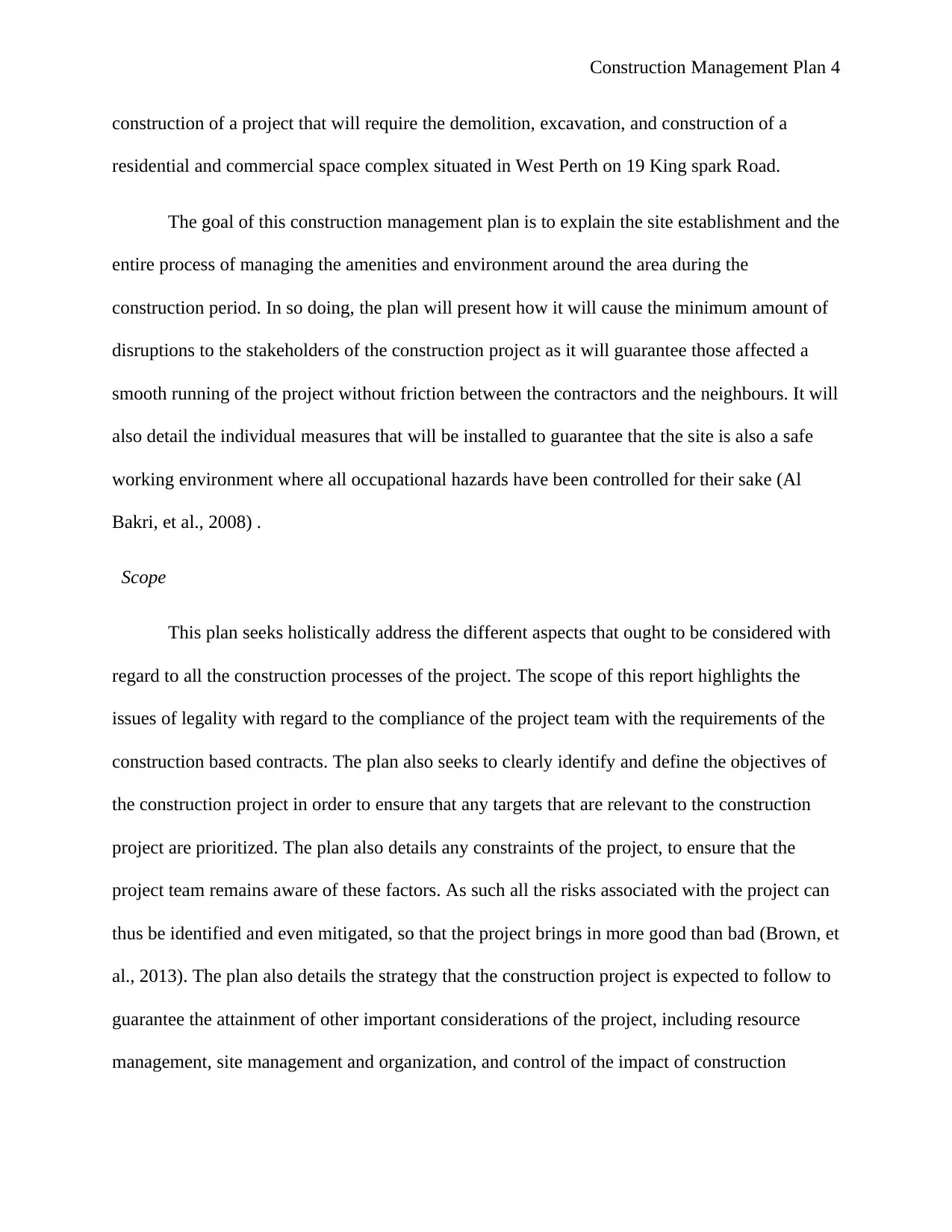
Construction Management Plan 4
construction of a project that will require the demolition, excavation, and construction of a
residential and commercial space complex situated in West Perth on 19 King spark Road.
The goal of this construction management plan is to explain the site establishment and the
entire process of managing the amenities and environment around the area during the
construction period. In so doing, the plan will present how it will cause the minimum amount of
disruptions to the stakeholders of the construction project as it will guarantee those affected a
smooth running of the project without friction between the contractors and the neighbours. It will
also detail the individual measures that will be installed to guarantee that the site is also a safe
working environment where all occupational hazards have been controlled for their sake (Al
Bakri, et al., 2008) .
Scope
This plan seeks holistically address the different aspects that ought to be considered with
regard to all the construction processes of the project. The scope of this report highlights the
issues of legality with regard to the compliance of the project team with the requirements of the
construction based contracts. The plan also seeks to clearly identify and define the objectives of
the construction project in order to ensure that any targets that are relevant to the construction
project are prioritized. The plan also details any constraints of the project, to ensure that the
project team remains aware of these factors. As such all the risks associated with the project can
thus be identified and even mitigated, so that the project brings in more good than bad (Brown, et
al., 2013). The plan also details the strategy that the construction project is expected to follow to
guarantee the attainment of other important considerations of the project, including resource
management, site management and organization, and control of the impact of construction
construction of a project that will require the demolition, excavation, and construction of a
residential and commercial space complex situated in West Perth on 19 King spark Road.
The goal of this construction management plan is to explain the site establishment and the
entire process of managing the amenities and environment around the area during the
construction period. In so doing, the plan will present how it will cause the minimum amount of
disruptions to the stakeholders of the construction project as it will guarantee those affected a
smooth running of the project without friction between the contractors and the neighbours. It will
also detail the individual measures that will be installed to guarantee that the site is also a safe
working environment where all occupational hazards have been controlled for their sake (Al
Bakri, et al., 2008) .
Scope
This plan seeks holistically address the different aspects that ought to be considered with
regard to all the construction processes of the project. The scope of this report highlights the
issues of legality with regard to the compliance of the project team with the requirements of the
construction based contracts. The plan also seeks to clearly identify and define the objectives of
the construction project in order to ensure that any targets that are relevant to the construction
project are prioritized. The plan also details any constraints of the project, to ensure that the
project team remains aware of these factors. As such all the risks associated with the project can
thus be identified and even mitigated, so that the project brings in more good than bad (Brown, et
al., 2013). The plan also details the strategy that the construction project is expected to follow to
guarantee the attainment of other important considerations of the project, including resource
management, site management and organization, and control of the impact of construction
Paraphrase This Document
Need a fresh take? Get an instant paraphrase of this document with our AI Paraphraser
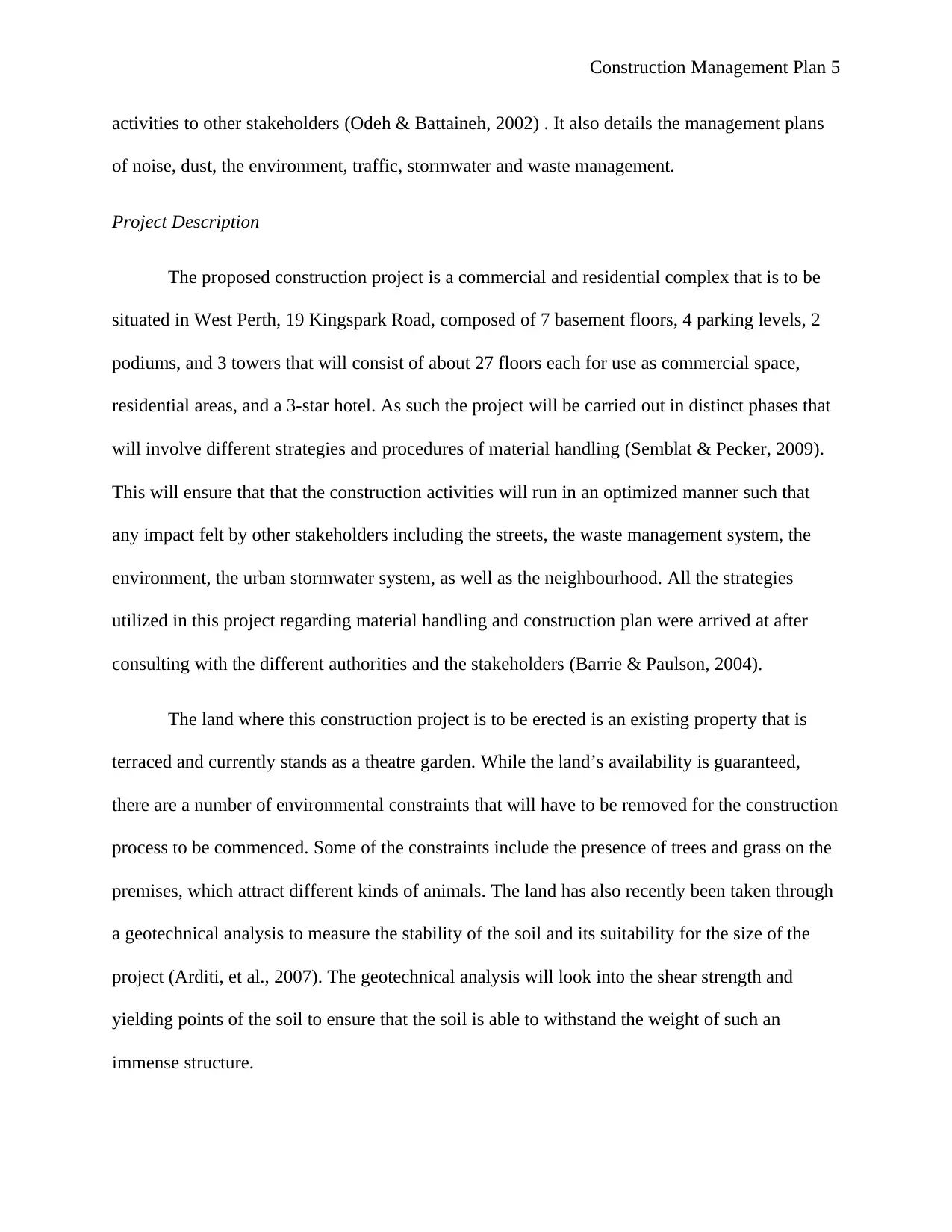
Construction Management Plan 5
activities to other stakeholders (Odeh & Battaineh, 2002) . It also details the management plans
of noise, dust, the environment, traffic, stormwater and waste management.
Project Description
The proposed construction project is a commercial and residential complex that is to be
situated in West Perth, 19 Kingspark Road, composed of 7 basement floors, 4 parking levels, 2
podiums, and 3 towers that will consist of about 27 floors each for use as commercial space,
residential areas, and a 3-star hotel. As such the project will be carried out in distinct phases that
will involve different strategies and procedures of material handling (Semblat & Pecker, 2009).
This will ensure that that the construction activities will run in an optimized manner such that
any impact felt by other stakeholders including the streets, the waste management system, the
environment, the urban stormwater system, as well as the neighbourhood. All the strategies
utilized in this project regarding material handling and construction plan were arrived at after
consulting with the different authorities and the stakeholders (Barrie & Paulson, 2004).
The land where this construction project is to be erected is an existing property that is
terraced and currently stands as a theatre garden. While the land’s availability is guaranteed,
there are a number of environmental constraints that will have to be removed for the construction
process to be commenced. Some of the constraints include the presence of trees and grass on the
premises, which attract different kinds of animals. The land has also recently been taken through
a geotechnical analysis to measure the stability of the soil and its suitability for the size of the
project (Arditi, et al., 2007). The geotechnical analysis will look into the shear strength and
yielding points of the soil to ensure that the soil is able to withstand the weight of such an
immense structure.
activities to other stakeholders (Odeh & Battaineh, 2002) . It also details the management plans
of noise, dust, the environment, traffic, stormwater and waste management.
Project Description
The proposed construction project is a commercial and residential complex that is to be
situated in West Perth, 19 Kingspark Road, composed of 7 basement floors, 4 parking levels, 2
podiums, and 3 towers that will consist of about 27 floors each for use as commercial space,
residential areas, and a 3-star hotel. As such the project will be carried out in distinct phases that
will involve different strategies and procedures of material handling (Semblat & Pecker, 2009).
This will ensure that that the construction activities will run in an optimized manner such that
any impact felt by other stakeholders including the streets, the waste management system, the
environment, the urban stormwater system, as well as the neighbourhood. All the strategies
utilized in this project regarding material handling and construction plan were arrived at after
consulting with the different authorities and the stakeholders (Barrie & Paulson, 2004).
The land where this construction project is to be erected is an existing property that is
terraced and currently stands as a theatre garden. While the land’s availability is guaranteed,
there are a number of environmental constraints that will have to be removed for the construction
process to be commenced. Some of the constraints include the presence of trees and grass on the
premises, which attract different kinds of animals. The land has also recently been taken through
a geotechnical analysis to measure the stability of the soil and its suitability for the size of the
project (Arditi, et al., 2007). The geotechnical analysis will look into the shear strength and
yielding points of the soil to ensure that the soil is able to withstand the weight of such an
immense structure.

Construction Management Plan 6
In addition, the project will be funded through a design and build type of contract
between the proprietor and the contractor. The proprietor is an insurance company in Adelaide,
seeking to open up offices in Perth in order to expand their business. This implies that all the
necessary budgeting has been done and the funds for commencing the project are ready and
available. Other than the geotechnical engineers, experts like the structural designers and
landscape architects are also on board the project to guarantee that the design is viable and the
project will run smoothly once it takes off. (Wolshon & Pande, 2016). The project will also be
overseen by an experienced construction manager who will guarantee that the construction
process runs in a coordinated manner. Finally the project is also working with a landscape
architect to guarantee that the landscape of the premises after the construction is complete is
aesthetically pleasing, in order for the project to remain attractive and become profitable to the
proprietor (Casto, 2000). The project entails 3 towers of 27 floors each, which will become
residential apartments, a commercial space, and a three-star hotel. The location appears to be
right in the middle of West Perth and this could really affect a lot of the residents, although the
plan is dedicated to ensuring that minimal disturbances are felt by the surrounding assets and
properties.
The purpose of this construction management plan is to ensure that the project is awarded
a development permit or approval as is conditioned by the local authorities. Other requirements
by these authorities prior to the commencement of construction include a notification to the
Council to commence development projects in their property and jurisdiction, as well as permits
for road occupancy during a construction project, application for road closure or even a
temporary lane allocation, permit for conducting operational works as well for operation during
after-hours (Lisle, et al., 2006). These Building approvals are to be obtained from a local
In addition, the project will be funded through a design and build type of contract
between the proprietor and the contractor. The proprietor is an insurance company in Adelaide,
seeking to open up offices in Perth in order to expand their business. This implies that all the
necessary budgeting has been done and the funds for commencing the project are ready and
available. Other than the geotechnical engineers, experts like the structural designers and
landscape architects are also on board the project to guarantee that the design is viable and the
project will run smoothly once it takes off. (Wolshon & Pande, 2016). The project will also be
overseen by an experienced construction manager who will guarantee that the construction
process runs in a coordinated manner. Finally the project is also working with a landscape
architect to guarantee that the landscape of the premises after the construction is complete is
aesthetically pleasing, in order for the project to remain attractive and become profitable to the
proprietor (Casto, 2000). The project entails 3 towers of 27 floors each, which will become
residential apartments, a commercial space, and a three-star hotel. The location appears to be
right in the middle of West Perth and this could really affect a lot of the residents, although the
plan is dedicated to ensuring that minimal disturbances are felt by the surrounding assets and
properties.
The purpose of this construction management plan is to ensure that the project is awarded
a development permit or approval as is conditioned by the local authorities. Other requirements
by these authorities prior to the commencement of construction include a notification to the
Council to commence development projects in their property and jurisdiction, as well as permits
for road occupancy during a construction project, application for road closure or even a
temporary lane allocation, permit for conducting operational works as well for operation during
after-hours (Lisle, et al., 2006). These Building approvals are to be obtained from a local
⊘ This is a preview!⊘
Do you want full access?
Subscribe today to unlock all pages.

Trusted by 1+ million students worldwide
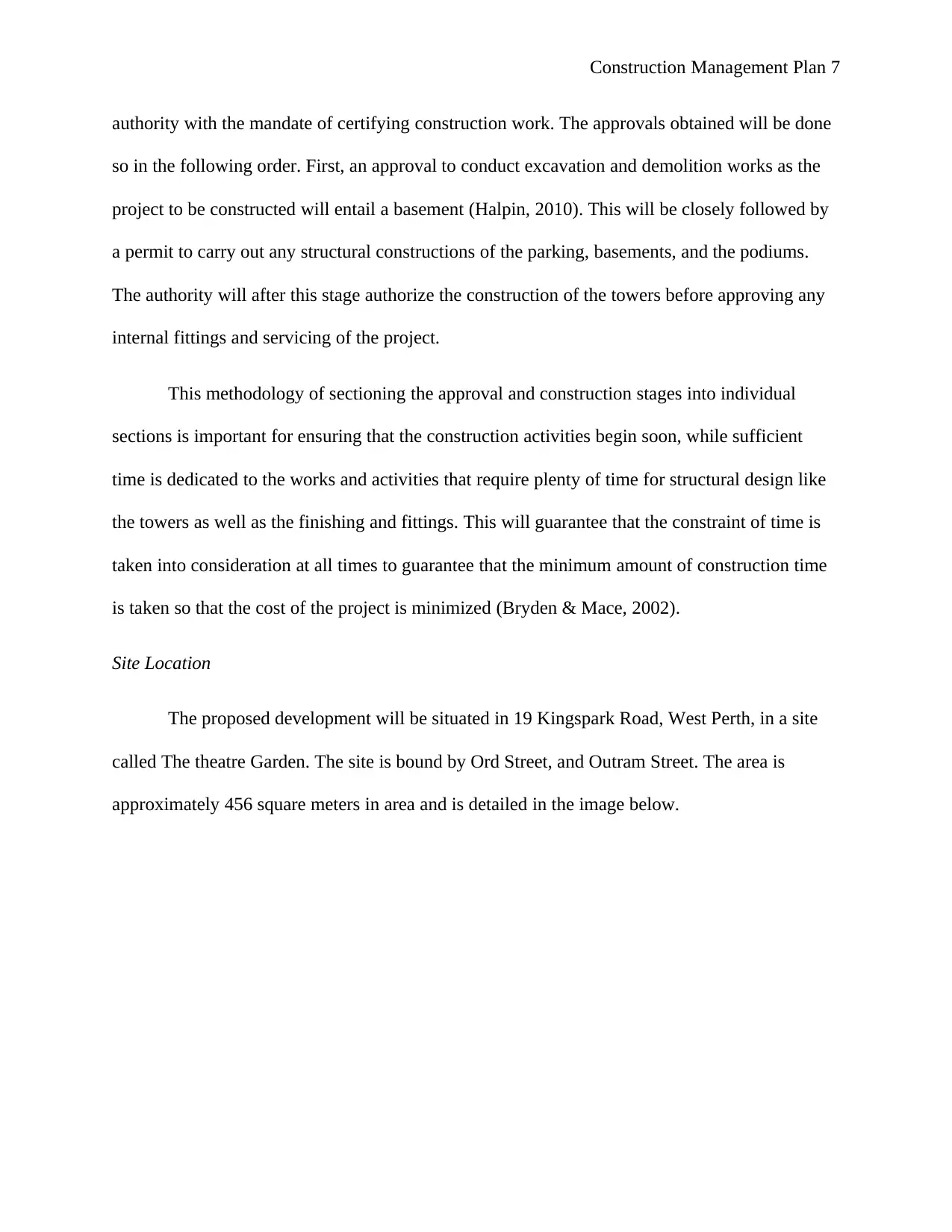
Construction Management Plan 7
authority with the mandate of certifying construction work. The approvals obtained will be done
so in the following order. First, an approval to conduct excavation and demolition works as the
project to be constructed will entail a basement (Halpin, 2010). This will be closely followed by
a permit to carry out any structural constructions of the parking, basements, and the podiums.
The authority will after this stage authorize the construction of the towers before approving any
internal fittings and servicing of the project.
This methodology of sectioning the approval and construction stages into individual
sections is important for ensuring that the construction activities begin soon, while sufficient
time is dedicated to the works and activities that require plenty of time for structural design like
the towers as well as the finishing and fittings. This will guarantee that the constraint of time is
taken into consideration at all times to guarantee that the minimum amount of construction time
is taken so that the cost of the project is minimized (Bryden & Mace, 2002).
Site Location
The proposed development will be situated in 19 Kingspark Road, West Perth, in a site
called The theatre Garden. The site is bound by Ord Street, and Outram Street. The area is
approximately 456 square meters in area and is detailed in the image below.
authority with the mandate of certifying construction work. The approvals obtained will be done
so in the following order. First, an approval to conduct excavation and demolition works as the
project to be constructed will entail a basement (Halpin, 2010). This will be closely followed by
a permit to carry out any structural constructions of the parking, basements, and the podiums.
The authority will after this stage authorize the construction of the towers before approving any
internal fittings and servicing of the project.
This methodology of sectioning the approval and construction stages into individual
sections is important for ensuring that the construction activities begin soon, while sufficient
time is dedicated to the works and activities that require plenty of time for structural design like
the towers as well as the finishing and fittings. This will guarantee that the constraint of time is
taken into consideration at all times to guarantee that the minimum amount of construction time
is taken so that the cost of the project is minimized (Bryden & Mace, 2002).
Site Location
The proposed development will be situated in 19 Kingspark Road, West Perth, in a site
called The theatre Garden. The site is bound by Ord Street, and Outram Street. The area is
approximately 456 square meters in area and is detailed in the image below.
Paraphrase This Document
Need a fresh take? Get an instant paraphrase of this document with our AI Paraphraser
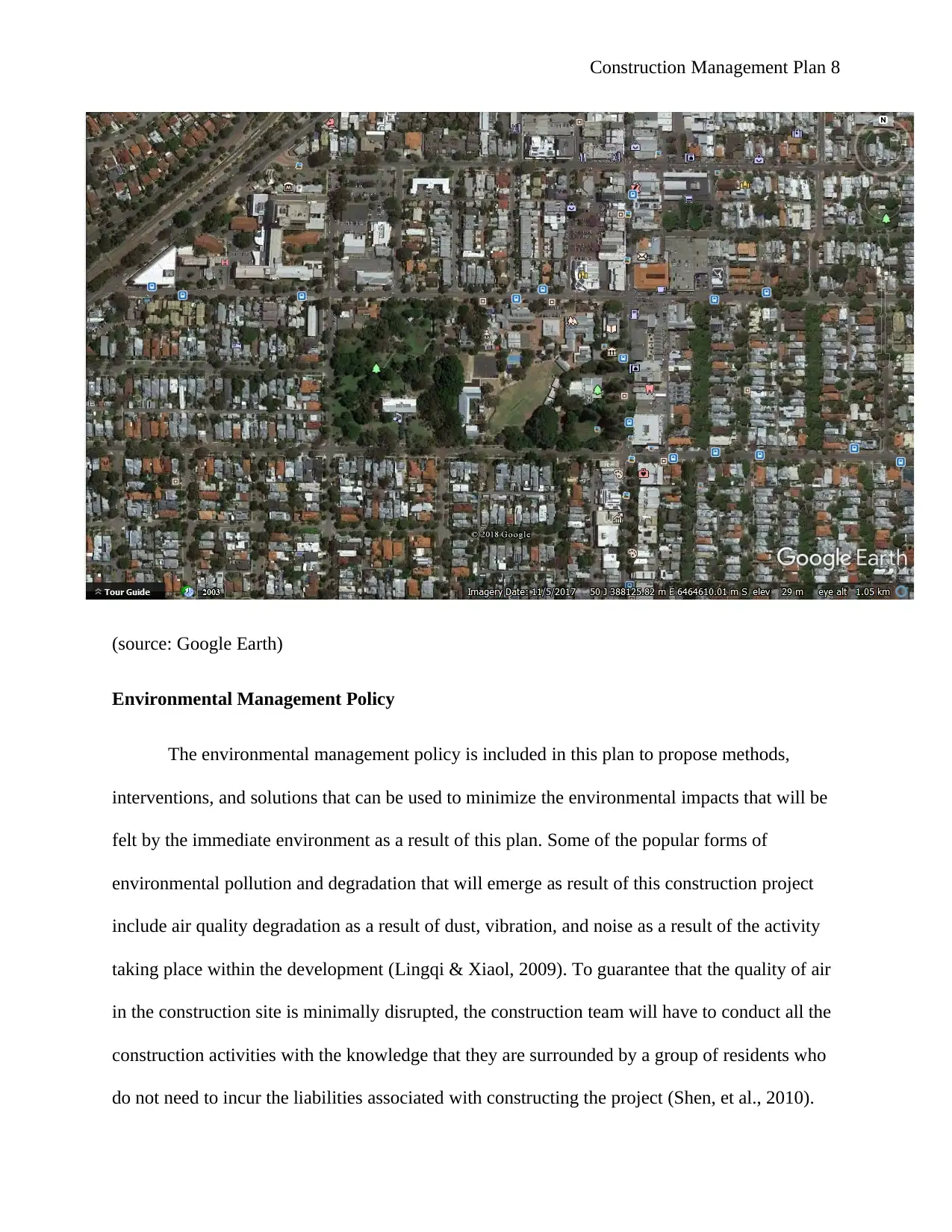
Construction Management Plan 8
(source: Google Earth)
Environmental Management Policy
The environmental management policy is included in this plan to propose methods,
interventions, and solutions that can be used to minimize the environmental impacts that will be
felt by the immediate environment as a result of this plan. Some of the popular forms of
environmental pollution and degradation that will emerge as result of this construction project
include air quality degradation as a result of dust, vibration, and noise as a result of the activity
taking place within the development (Lingqi & Xiaol, 2009). To guarantee that the quality of air
in the construction site is minimally disrupted, the construction team will have to conduct all the
construction activities with the knowledge that they are surrounded by a group of residents who
do not need to incur the liabilities associated with constructing the project (Shen, et al., 2010).
(source: Google Earth)
Environmental Management Policy
The environmental management policy is included in this plan to propose methods,
interventions, and solutions that can be used to minimize the environmental impacts that will be
felt by the immediate environment as a result of this plan. Some of the popular forms of
environmental pollution and degradation that will emerge as result of this construction project
include air quality degradation as a result of dust, vibration, and noise as a result of the activity
taking place within the development (Lingqi & Xiaol, 2009). To guarantee that the quality of air
in the construction site is minimally disrupted, the construction team will have to conduct all the
construction activities with the knowledge that they are surrounded by a group of residents who
do not need to incur the liabilities associated with constructing the project (Shen, et al., 2010).
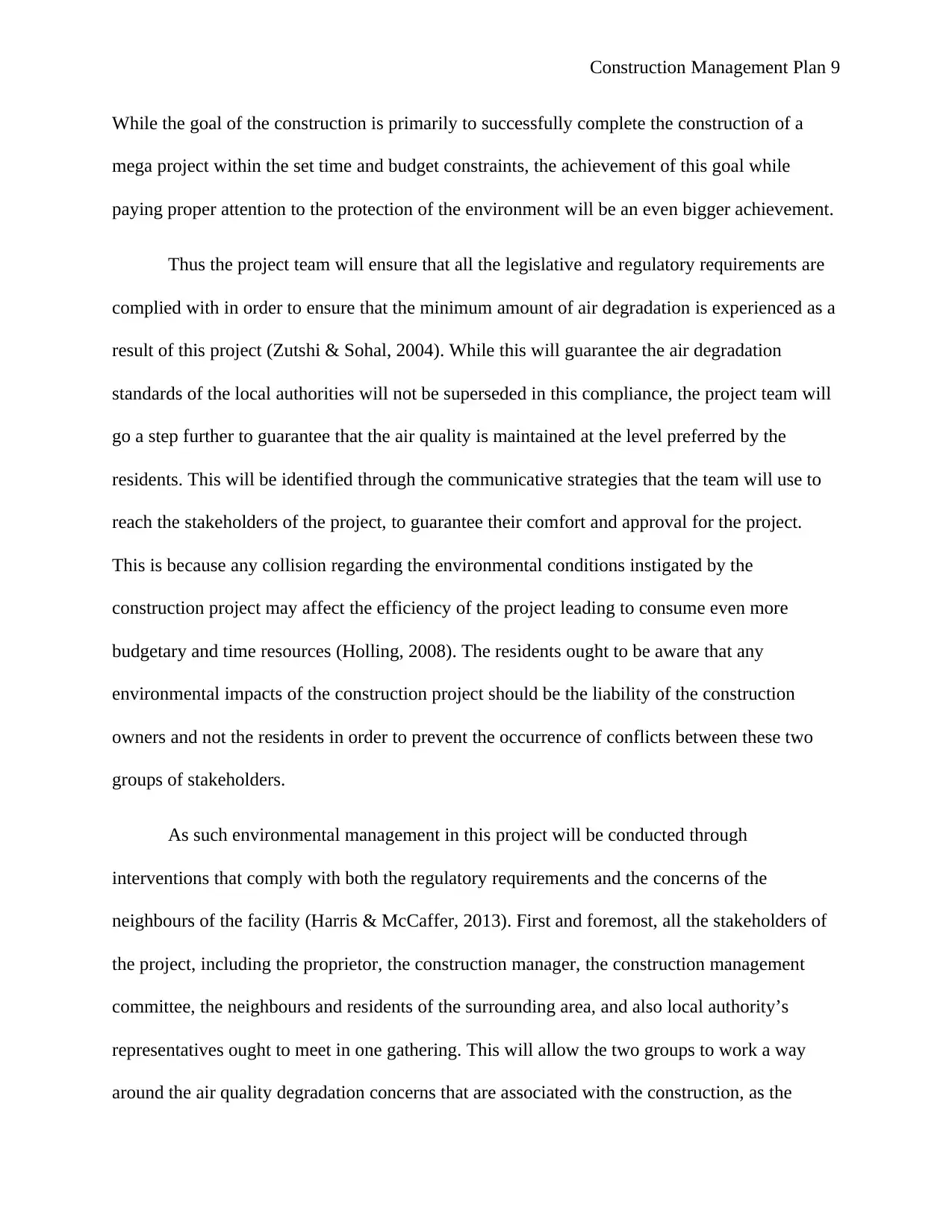
Construction Management Plan 9
While the goal of the construction is primarily to successfully complete the construction of a
mega project within the set time and budget constraints, the achievement of this goal while
paying proper attention to the protection of the environment will be an even bigger achievement.
Thus the project team will ensure that all the legislative and regulatory requirements are
complied with in order to ensure that the minimum amount of air degradation is experienced as a
result of this project (Zutshi & Sohal, 2004). While this will guarantee the air degradation
standards of the local authorities will not be superseded in this compliance, the project team will
go a step further to guarantee that the air quality is maintained at the level preferred by the
residents. This will be identified through the communicative strategies that the team will use to
reach the stakeholders of the project, to guarantee their comfort and approval for the project.
This is because any collision regarding the environmental conditions instigated by the
construction project may affect the efficiency of the project leading to consume even more
budgetary and time resources (Holling, 2008). The residents ought to be aware that any
environmental impacts of the construction project should be the liability of the construction
owners and not the residents in order to prevent the occurrence of conflicts between these two
groups of stakeholders.
As such environmental management in this project will be conducted through
interventions that comply with both the regulatory requirements and the concerns of the
neighbours of the facility (Harris & McCaffer, 2013). First and foremost, all the stakeholders of
the project, including the proprietor, the construction manager, the construction management
committee, the neighbours and residents of the surrounding area, and also local authority’s
representatives ought to meet in one gathering. This will allow the two groups to work a way
around the air quality degradation concerns that are associated with the construction, as the
While the goal of the construction is primarily to successfully complete the construction of a
mega project within the set time and budget constraints, the achievement of this goal while
paying proper attention to the protection of the environment will be an even bigger achievement.
Thus the project team will ensure that all the legislative and regulatory requirements are
complied with in order to ensure that the minimum amount of air degradation is experienced as a
result of this project (Zutshi & Sohal, 2004). While this will guarantee the air degradation
standards of the local authorities will not be superseded in this compliance, the project team will
go a step further to guarantee that the air quality is maintained at the level preferred by the
residents. This will be identified through the communicative strategies that the team will use to
reach the stakeholders of the project, to guarantee their comfort and approval for the project.
This is because any collision regarding the environmental conditions instigated by the
construction project may affect the efficiency of the project leading to consume even more
budgetary and time resources (Holling, 2008). The residents ought to be aware that any
environmental impacts of the construction project should be the liability of the construction
owners and not the residents in order to prevent the occurrence of conflicts between these two
groups of stakeholders.
As such environmental management in this project will be conducted through
interventions that comply with both the regulatory requirements and the concerns of the
neighbours of the facility (Harris & McCaffer, 2013). First and foremost, all the stakeholders of
the project, including the proprietor, the construction manager, the construction management
committee, the neighbours and residents of the surrounding area, and also local authority’s
representatives ought to meet in one gathering. This will allow the two groups to work a way
around the air quality degradation concerns that are associated with the construction, as the
⊘ This is a preview!⊘
Do you want full access?
Subscribe today to unlock all pages.

Trusted by 1+ million students worldwide
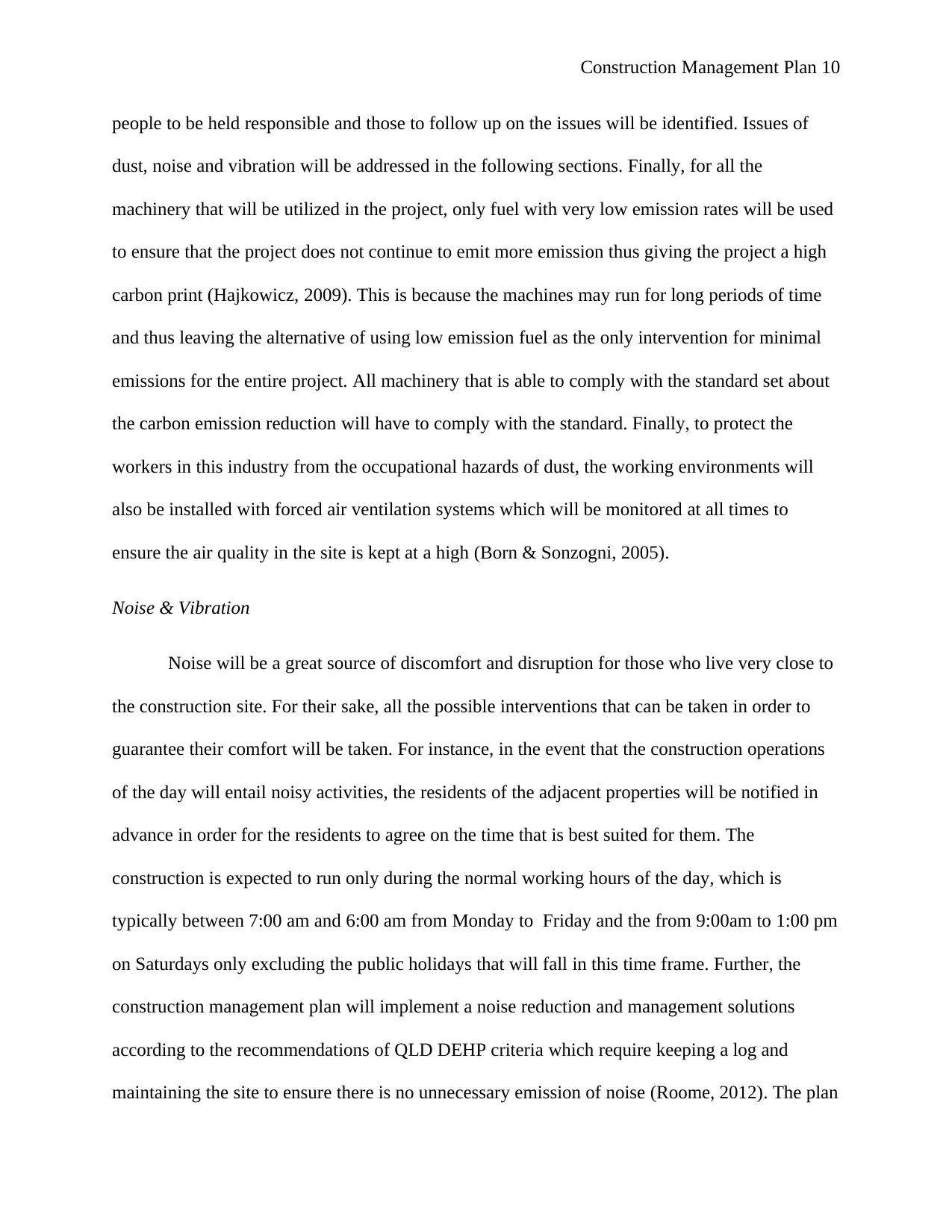
Construction Management Plan 10
people to be held responsible and those to follow up on the issues will be identified. Issues of
dust, noise and vibration will be addressed in the following sections. Finally, for all the
machinery that will be utilized in the project, only fuel with very low emission rates will be used
to ensure that the project does not continue to emit more emission thus giving the project a high
carbon print (Hajkowicz, 2009). This is because the machines may run for long periods of time
and thus leaving the alternative of using low emission fuel as the only intervention for minimal
emissions for the entire project. All machinery that is able to comply with the standard set about
the carbon emission reduction will have to comply with the standard. Finally, to protect the
workers in this industry from the occupational hazards of dust, the working environments will
also be installed with forced air ventilation systems which will be monitored at all times to
ensure the air quality in the site is kept at a high (Born & Sonzogni, 2005).
Noise & Vibration
Noise will be a great source of discomfort and disruption for those who live very close to
the construction site. For their sake, all the possible interventions that can be taken in order to
guarantee their comfort will be taken. For instance, in the event that the construction operations
of the day will entail noisy activities, the residents of the adjacent properties will be notified in
advance in order for the residents to agree on the time that is best suited for them. The
construction is expected to run only during the normal working hours of the day, which is
typically between 7:00 am and 6:00 am from Monday to Friday and the from 9:00am to 1:00 pm
on Saturdays only excluding the public holidays that will fall in this time frame. Further, the
construction management plan will implement a noise reduction and management solutions
according to the recommendations of QLD DEHP criteria which require keeping a log and
maintaining the site to ensure there is no unnecessary emission of noise (Roome, 2012). The plan
people to be held responsible and those to follow up on the issues will be identified. Issues of
dust, noise and vibration will be addressed in the following sections. Finally, for all the
machinery that will be utilized in the project, only fuel with very low emission rates will be used
to ensure that the project does not continue to emit more emission thus giving the project a high
carbon print (Hajkowicz, 2009). This is because the machines may run for long periods of time
and thus leaving the alternative of using low emission fuel as the only intervention for minimal
emissions for the entire project. All machinery that is able to comply with the standard set about
the carbon emission reduction will have to comply with the standard. Finally, to protect the
workers in this industry from the occupational hazards of dust, the working environments will
also be installed with forced air ventilation systems which will be monitored at all times to
ensure the air quality in the site is kept at a high (Born & Sonzogni, 2005).
Noise & Vibration
Noise will be a great source of discomfort and disruption for those who live very close to
the construction site. For their sake, all the possible interventions that can be taken in order to
guarantee their comfort will be taken. For instance, in the event that the construction operations
of the day will entail noisy activities, the residents of the adjacent properties will be notified in
advance in order for the residents to agree on the time that is best suited for them. The
construction is expected to run only during the normal working hours of the day, which is
typically between 7:00 am and 6:00 am from Monday to Friday and the from 9:00am to 1:00 pm
on Saturdays only excluding the public holidays that will fall in this time frame. Further, the
construction management plan will implement a noise reduction and management solutions
according to the recommendations of QLD DEHP criteria which require keeping a log and
maintaining the site to ensure there is no unnecessary emission of noise (Roome, 2012). The plan
Paraphrase This Document
Need a fresh take? Get an instant paraphrase of this document with our AI Paraphraser
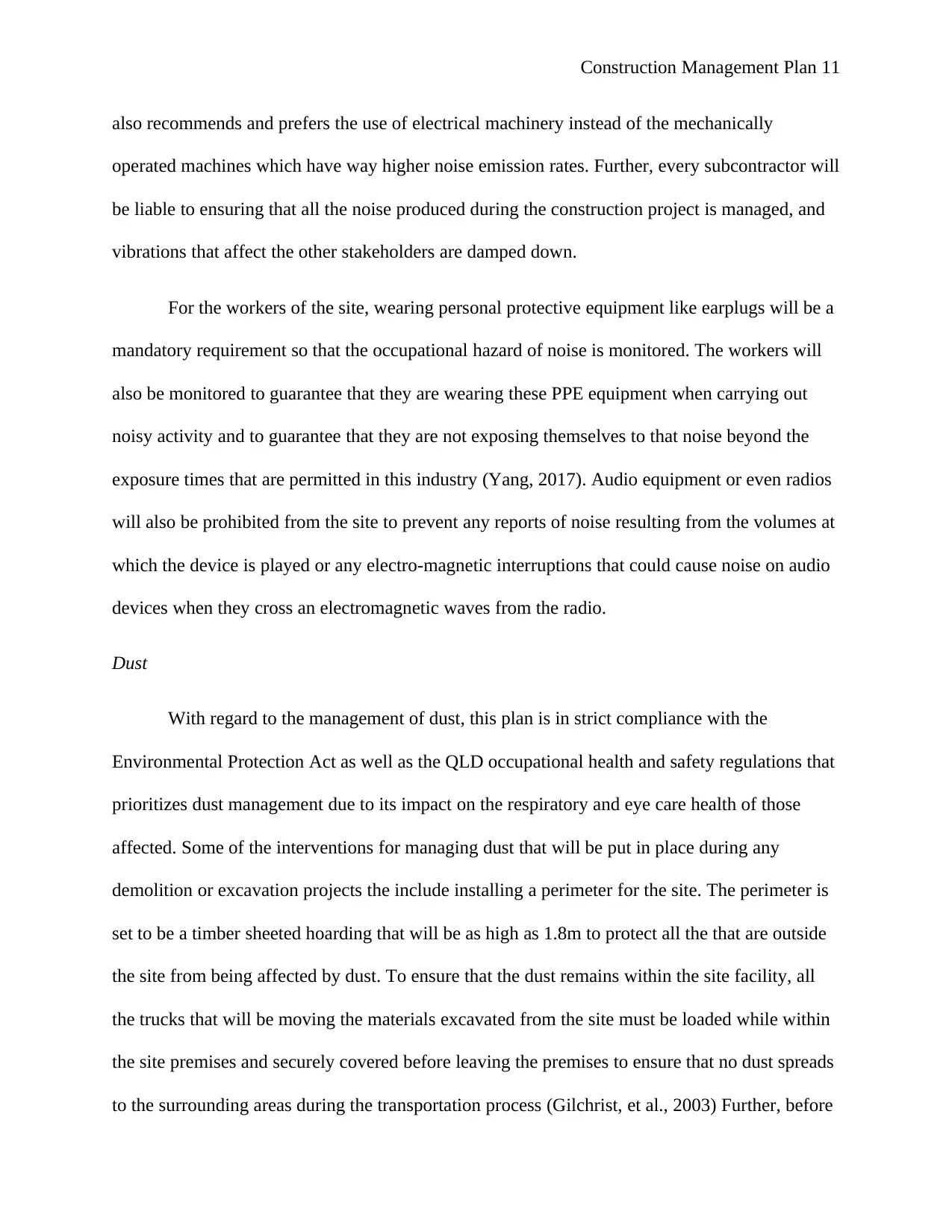
Construction Management Plan 11
also recommends and prefers the use of electrical machinery instead of the mechanically
operated machines which have way higher noise emission rates. Further, every subcontractor will
be liable to ensuring that all the noise produced during the construction project is managed, and
vibrations that affect the other stakeholders are damped down.
For the workers of the site, wearing personal protective equipment like earplugs will be a
mandatory requirement so that the occupational hazard of noise is monitored. The workers will
also be monitored to guarantee that they are wearing these PPE equipment when carrying out
noisy activity and to guarantee that they are not exposing themselves to that noise beyond the
exposure times that are permitted in this industry (Yang, 2017). Audio equipment or even radios
will also be prohibited from the site to prevent any reports of noise resulting from the volumes at
which the device is played or any electro-magnetic interruptions that could cause noise on audio
devices when they cross an electromagnetic waves from the radio.
Dust
With regard to the management of dust, this plan is in strict compliance with the
Environmental Protection Act as well as the QLD occupational health and safety regulations that
prioritizes dust management due to its impact on the respiratory and eye care health of those
affected. Some of the interventions for managing dust that will be put in place during any
demolition or excavation projects the include installing a perimeter for the site. The perimeter is
set to be a timber sheeted hoarding that will be as high as 1.8m to protect all the that are outside
the site from being affected by dust. To ensure that the dust remains within the site facility, all
the trucks that will be moving the materials excavated from the site must be loaded while within
the site premises and securely covered before leaving the premises to ensure that no dust spreads
to the surrounding areas during the transportation process (Gilchrist, et al., 2003) Further, before
also recommends and prefers the use of electrical machinery instead of the mechanically
operated machines which have way higher noise emission rates. Further, every subcontractor will
be liable to ensuring that all the noise produced during the construction project is managed, and
vibrations that affect the other stakeholders are damped down.
For the workers of the site, wearing personal protective equipment like earplugs will be a
mandatory requirement so that the occupational hazard of noise is monitored. The workers will
also be monitored to guarantee that they are wearing these PPE equipment when carrying out
noisy activity and to guarantee that they are not exposing themselves to that noise beyond the
exposure times that are permitted in this industry (Yang, 2017). Audio equipment or even radios
will also be prohibited from the site to prevent any reports of noise resulting from the volumes at
which the device is played or any electro-magnetic interruptions that could cause noise on audio
devices when they cross an electromagnetic waves from the radio.
Dust
With regard to the management of dust, this plan is in strict compliance with the
Environmental Protection Act as well as the QLD occupational health and safety regulations that
prioritizes dust management due to its impact on the respiratory and eye care health of those
affected. Some of the interventions for managing dust that will be put in place during any
demolition or excavation projects the include installing a perimeter for the site. The perimeter is
set to be a timber sheeted hoarding that will be as high as 1.8m to protect all the that are outside
the site from being affected by dust. To ensure that the dust remains within the site facility, all
the trucks that will be moving the materials excavated from the site must be loaded while within
the site premises and securely covered before leaving the premises to ensure that no dust spreads
to the surrounding areas during the transportation process (Gilchrist, et al., 2003) Further, before
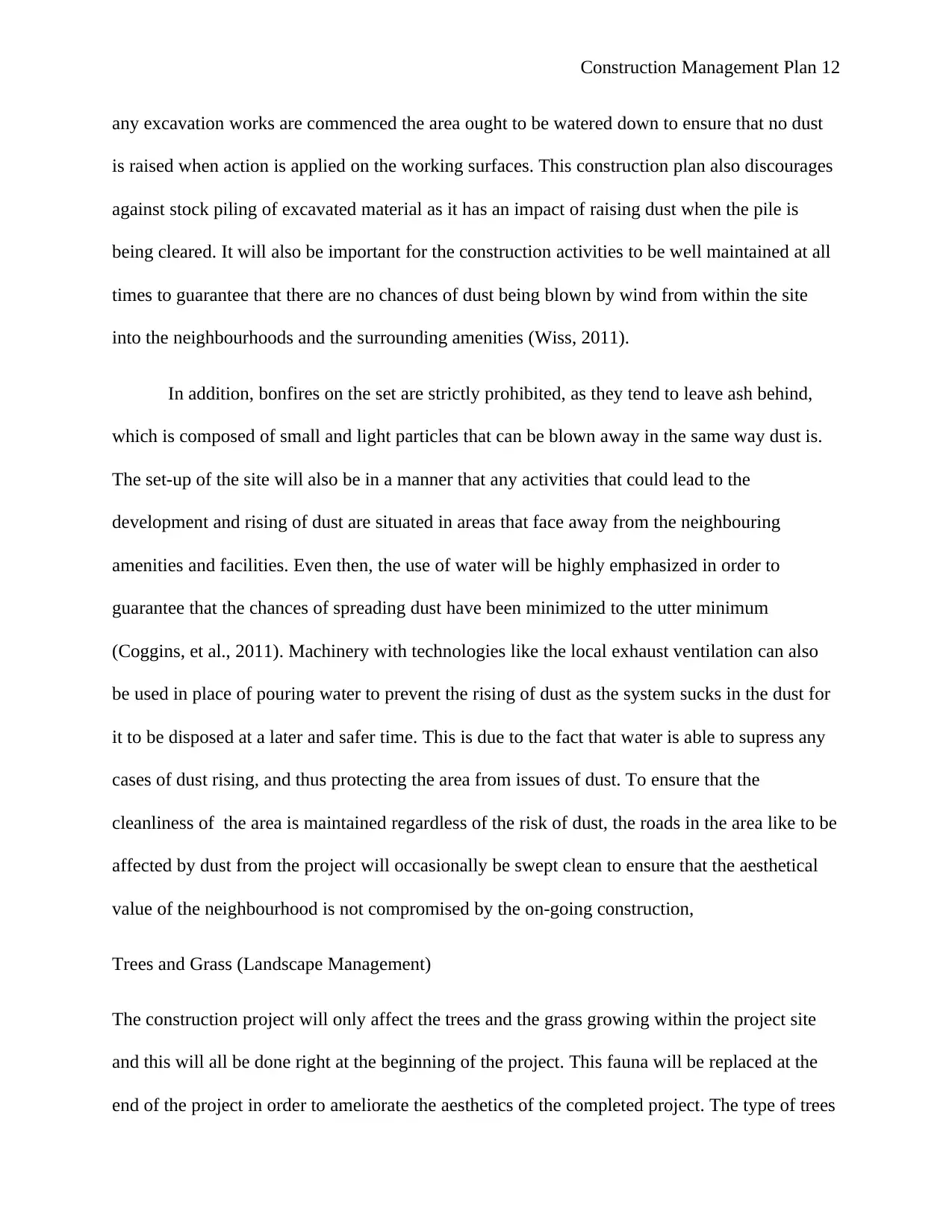
Construction Management Plan 12
any excavation works are commenced the area ought to be watered down to ensure that no dust
is raised when action is applied on the working surfaces. This construction plan also discourages
against stock piling of excavated material as it has an impact of raising dust when the pile is
being cleared. It will also be important for the construction activities to be well maintained at all
times to guarantee that there are no chances of dust being blown by wind from within the site
into the neighbourhoods and the surrounding amenities (Wiss, 2011).
In addition, bonfires on the set are strictly prohibited, as they tend to leave ash behind,
which is composed of small and light particles that can be blown away in the same way dust is.
The set-up of the site will also be in a manner that any activities that could lead to the
development and rising of dust are situated in areas that face away from the neighbouring
amenities and facilities. Even then, the use of water will be highly emphasized in order to
guarantee that the chances of spreading dust have been minimized to the utter minimum
(Coggins, et al., 2011). Machinery with technologies like the local exhaust ventilation can also
be used in place of pouring water to prevent the rising of dust as the system sucks in the dust for
it to be disposed at a later and safer time. This is due to the fact that water is able to supress any
cases of dust rising, and thus protecting the area from issues of dust. To ensure that the
cleanliness of the area is maintained regardless of the risk of dust, the roads in the area like to be
affected by dust from the project will occasionally be swept clean to ensure that the aesthetical
value of the neighbourhood is not compromised by the on-going construction,
Trees and Grass (Landscape Management)
The construction project will only affect the trees and the grass growing within the project site
and this will all be done right at the beginning of the project. This fauna will be replaced at the
end of the project in order to ameliorate the aesthetics of the completed project. The type of trees
any excavation works are commenced the area ought to be watered down to ensure that no dust
is raised when action is applied on the working surfaces. This construction plan also discourages
against stock piling of excavated material as it has an impact of raising dust when the pile is
being cleared. It will also be important for the construction activities to be well maintained at all
times to guarantee that there are no chances of dust being blown by wind from within the site
into the neighbourhoods and the surrounding amenities (Wiss, 2011).
In addition, bonfires on the set are strictly prohibited, as they tend to leave ash behind,
which is composed of small and light particles that can be blown away in the same way dust is.
The set-up of the site will also be in a manner that any activities that could lead to the
development and rising of dust are situated in areas that face away from the neighbouring
amenities and facilities. Even then, the use of water will be highly emphasized in order to
guarantee that the chances of spreading dust have been minimized to the utter minimum
(Coggins, et al., 2011). Machinery with technologies like the local exhaust ventilation can also
be used in place of pouring water to prevent the rising of dust as the system sucks in the dust for
it to be disposed at a later and safer time. This is due to the fact that water is able to supress any
cases of dust rising, and thus protecting the area from issues of dust. To ensure that the
cleanliness of the area is maintained regardless of the risk of dust, the roads in the area like to be
affected by dust from the project will occasionally be swept clean to ensure that the aesthetical
value of the neighbourhood is not compromised by the on-going construction,
Trees and Grass (Landscape Management)
The construction project will only affect the trees and the grass growing within the project site
and this will all be done right at the beginning of the project. This fauna will be replaced at the
end of the project in order to ameliorate the aesthetics of the completed project. The type of trees
⊘ This is a preview!⊘
Do you want full access?
Subscribe today to unlock all pages.

Trusted by 1+ million students worldwide
1 out of 51
Related Documents
Your All-in-One AI-Powered Toolkit for Academic Success.
+13062052269
info@desklib.com
Available 24*7 on WhatsApp / Email
![[object Object]](/_next/static/media/star-bottom.7253800d.svg)
Unlock your academic potential
Copyright © 2020–2025 A2Z Services. All Rights Reserved. Developed and managed by ZUCOL.





